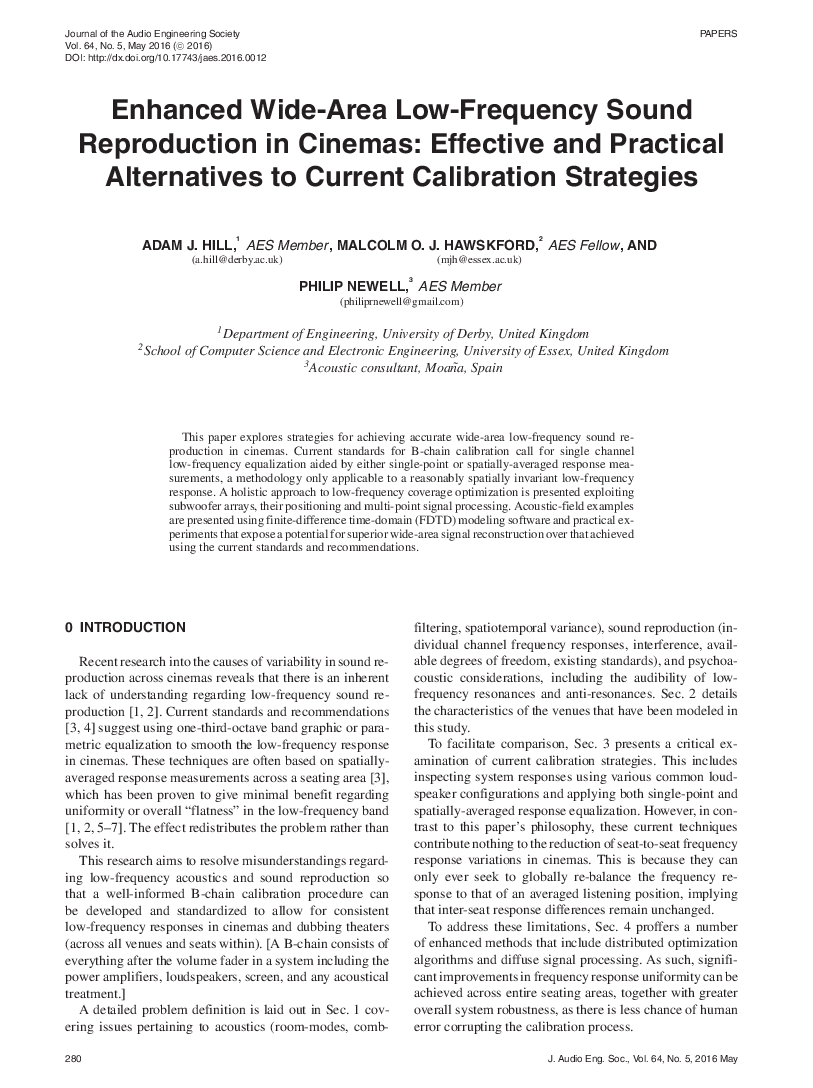Home / Publications / E-library page
You are currently logged in as an
Institutional Subscriber.
If you would like to logout,
please click on the button below.
Home / Publications / E-library page
Only AES members and Institutional Journal Subscribers can download
The current strategies for the low-frequency calibration of cinema sound systems are based on a flawed premise of low-frequency acoustics and psychoacoustics. This research shows that there is virtually no benefit in terms of spatiotemporal variance reduction: pre- and post-calibrated systems will exhibit equally position-dependent listening experience differences. For modern cinemas, the typical focus on room-modes when designing a low frequency calibration system is not necessary because the dimensions of the space coupled with low reverberation time results in Schroeder frequencies around 35 Hz. Above this value, effects of room-modes are not perceptible. Comb-filtering between sources and low-order reflections is the primary cause of high spatial variance. Furthermore, there is no evidence that spatial averaging techniques used for measurement and equalization are subjectively beneficial. A new approach needs to be invented.
Author (s): Hill, Adam J.; Hawksford, Malcolm O. J.; Newell, Philip
Affiliation:
Department of Engineering, University of Derby, United Kingdom; School of Computer Science and Electronic Engineering, University of Essex, United Kingdom; Acoustic consultant, Moaña Spain
(See document for exact affiliation information.)
Publication Date:
2016-05-06
Import into BibTeX
Permalink: https://aes2.org/publications/elibrary-page/?id=18134
(773KB)
Click to purchase paper as a non-member or login as an AES member. If your company or school subscribes to the E-Library then switch to the institutional version. If you are not an AES member Join the AES. If you need to check your member status, login to the Member Portal.

Hill, Adam J.; Hawksford, Malcolm O. J.; Newell, Philip; 2016; Enhanced Wide-Area Low-Frequency Sound Reproduction in Cinemas: Effective and Practical Alternatives to Current Calibration Strategies [PDF]; Department of Engineering, University of Derby, United Kingdom; School of Computer Science and Electronic Engineering, University of Essex, United Kingdom; Acoustic consultant, Moaña Spain; Paper ; Available from: https://aes2.org/publications/elibrary-page/?id=18134
Hill, Adam J.; Hawksford, Malcolm O. J.; Newell, Philip; Enhanced Wide-Area Low-Frequency Sound Reproduction in Cinemas: Effective and Practical Alternatives to Current Calibration Strategies [PDF]; Department of Engineering, University of Derby, United Kingdom; School of Computer Science and Electronic Engineering, University of Essex, United Kingdom; Acoustic consultant, Moaña Spain; Paper ; 2016 Available: https://aes2.org/publications/elibrary-page/?id=18134
@article{hill2016enhanced,
author={hill adam j. and hawksford malcolm o. j. and newell philip},
journal={journal of the audio engineering society},
title={enhanced wide-area low-frequency sound reproduction in cinemas: effective and practical alternatives to current calibration strategies},
year={2016},
volume={64},
issue={5},
pages={280-298},
month={may},}
TY – paper
TI – Enhanced Wide-Area Low-Frequency Sound Reproduction in Cinemas: Effective and Practical Alternatives to Current Calibration Strategies
SP – 280 EP – 298
AU – Hill, Adam J.
AU – Hawksford, Malcolm O. J.
AU – Newell, Philip
PY – 2016
JO – Journal of the Audio Engineering Society
VO – 64
IS – 5
Y1 – May 2016